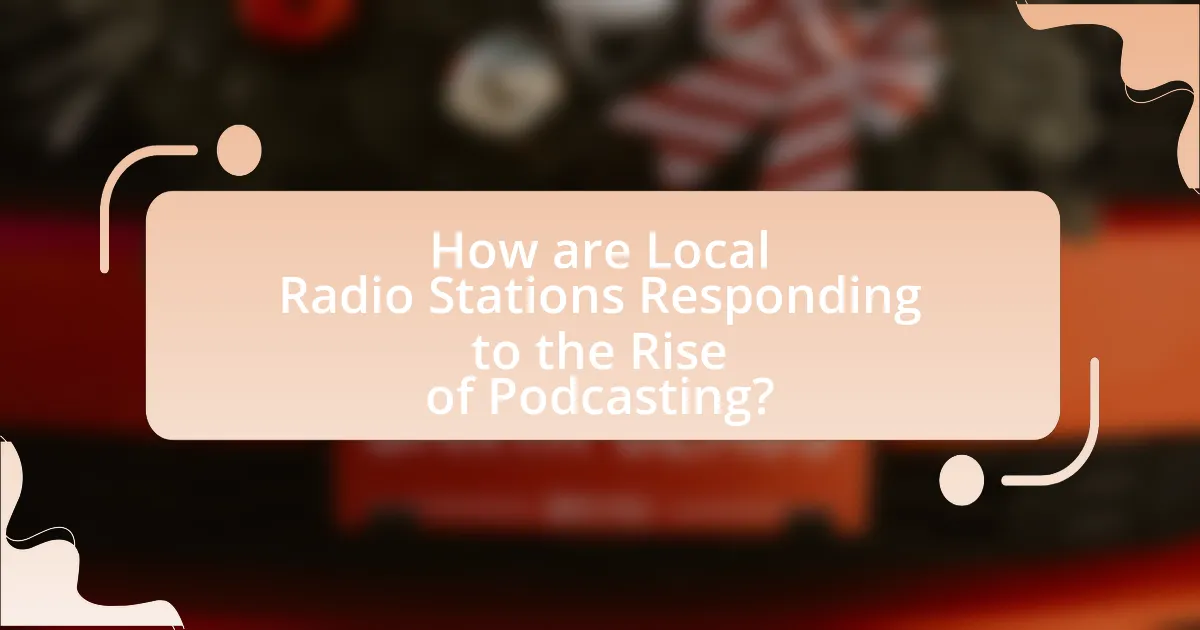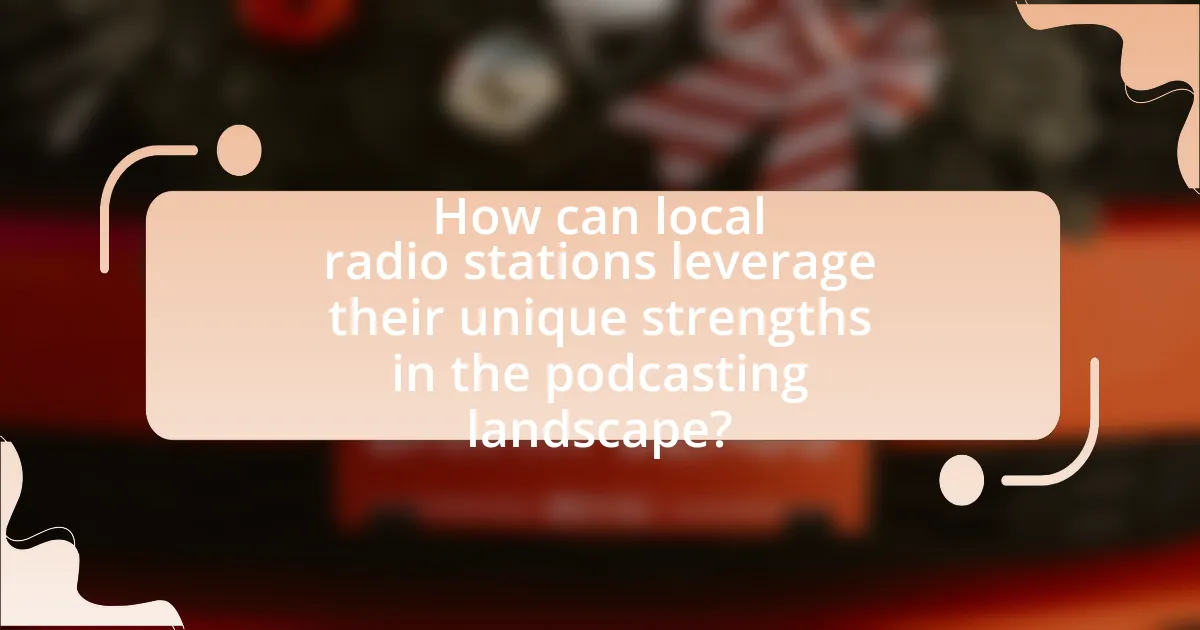Local radio stations are adapting to the rise of podcasting by creating original podcast content and integrating it into their programming to reach a broader audience. This shift is driven by changing listener preferences, as evidenced by a 2022 report indicating that 41% of Americans aged 12 and older listen to podcasts monthly. Local stations face challenges such as audience retention and revenue generation, prompting them to enhance their content through community engagement and technological advancements. Strategies include forming partnerships with digital platforms, diversifying content offerings, and utilizing audience feedback to remain competitive in the evolving media landscape.

How are Local Radio Stations Responding to the Rise of Podcasting?
Local radio stations are responding to the rise of podcasting by creating their own podcast content and integrating it into their programming. This adaptation allows them to reach a broader audience and engage listeners who prefer on-demand audio. According to a 2022 report by Edison Research, 41% of Americans aged 12 and older listen to podcasts monthly, prompting radio stations to leverage this trend by producing original shows that reflect local interests and issues. Additionally, many stations are collaborating with established podcasters to enhance their content offerings and attract new listeners, thereby maintaining relevance in a changing media landscape.
What challenges do local radio stations face with the growth of podcasting?
Local radio stations face significant challenges due to the growth of podcasting, primarily in audience retention and revenue generation. As podcasting offers on-demand content that caters to specific interests, local radio struggles to compete for listener attention, leading to declining audiences. According to a 2022 report by Edison Research, 41% of Americans aged 12 and older listen to podcasts monthly, highlighting the shift in listener preferences. Additionally, local radio stations often rely on traditional advertising revenue, which is increasingly threatened by the more targeted advertising capabilities of podcasts. This shift in advertising dynamics further complicates financial sustainability for local radio, as advertisers may prefer the measurable engagement that podcasts provide.
How does audience behavior impact local radio station listenership?
Audience behavior significantly impacts local radio station listenership by influencing programming choices and engagement strategies. When listeners demonstrate preferences for specific genres, topics, or formats, local radio stations adapt their content to align with these interests, thereby increasing their audience base. For instance, a study by Nielsen found that local radio stations that tailored their programming to reflect community interests saw a 20% increase in listener engagement. Additionally, audience feedback through social media and surveys allows stations to refine their offerings, ensuring they remain relevant and appealing to their target demographics. This responsiveness to audience behavior ultimately drives higher listenership and loyalty among local radio audiences.
What technological advancements are influencing local radio’s adaptation?
Technological advancements such as digital streaming, mobile applications, and social media integration are significantly influencing local radio’s adaptation. Digital streaming allows local stations to reach broader audiences beyond their traditional broadcast range, while mobile applications enable listeners to access content on-the-go, enhancing user engagement. Additionally, social media integration facilitates real-time interaction with audiences, allowing stations to promote their content and gather listener feedback effectively. These advancements are essential for local radio stations to remain competitive in an era increasingly dominated by podcasting and on-demand audio content.
What strategies are local radio stations implementing to compete with podcasts?
Local radio stations are implementing strategies such as enhancing local content, leveraging community engagement, and adopting digital platforms to compete with podcasts. By focusing on hyper-local news, events, and personalities, radio stations create unique content that resonates with their audience, differentiating themselves from the broader appeal of podcasts. Additionally, many stations are increasing their presence on social media and streaming platforms, allowing them to reach listeners who prefer on-demand content. According to a 2022 Nielsen report, local radio remains a trusted source for news and entertainment, which local stations capitalize on by fostering community connections and promoting local businesses through sponsorships and events.
How are local radio stations enhancing their content to attract listeners?
Local radio stations are enhancing their content by integrating podcasting elements, offering on-demand programming, and creating niche content tailored to specific audience interests. This adaptation allows stations to reach listeners who prefer flexible listening options, as evidenced by a 2022 Nielsen report indicating that 41% of Americans aged 12 and older listen to podcasts monthly. Additionally, local stations are collaborating with community influencers and utilizing social media platforms to engage audiences, thereby increasing listener interaction and loyalty. These strategies not only attract new listeners but also retain existing ones by providing diverse and relevant content.
What partnerships are local radio stations forming to expand their reach?
Local radio stations are forming partnerships with digital platforms and podcast networks to expand their reach. These collaborations enable radio stations to distribute their content through streaming services and podcasting platforms, thereby accessing a broader audience. For instance, partnerships with companies like Spotify and Apple Podcasts allow local stations to upload their shows as podcasts, increasing visibility and listener engagement. Additionally, collaborations with social media platforms enhance promotional efforts, driving traffic to their broadcasts and podcasts.

What role does content diversification play in local radio adaptation?
Content diversification is crucial for local radio adaptation as it enables stations to broaden their audience reach and enhance listener engagement. By incorporating various content types, such as podcasts, live shows, and community-focused segments, local radio can cater to diverse listener preferences and interests. This strategy is supported by research indicating that stations that diversify their content experience increased listener retention and attract new demographics, ultimately leading to higher advertising revenue. For instance, a study by the Pew Research Center found that 44% of Americans listen to podcasts, highlighting the importance of integrating podcasting into local radio programming to remain competitive in the evolving media landscape.
How are local radio stations incorporating podcasting elements into their programming?
Local radio stations are incorporating podcasting elements into their programming by creating on-demand content that complements their live broadcasts. This includes producing original podcasts that feature local news, interviews, and community stories, allowing listeners to engage with content at their convenience. For example, many stations are repurposing segments from their live shows into podcast episodes, which not only extends the reach of their content but also attracts a younger audience that prefers on-demand listening. Additionally, local radio stations are utilizing podcasting platforms to distribute their content, making it accessible on various streaming services, thereby enhancing their overall audience engagement and retention.
What types of content are local radio stations producing to engage podcast audiences?
Local radio stations are producing a variety of content types to engage podcast audiences, including localized news segments, interviews with community figures, and thematic storytelling. These content types cater to the interests of local listeners while leveraging the intimate and on-demand nature of podcasts. For instance, localized news segments provide timely information relevant to the community, while interviews with local artists or business owners foster a sense of connection and relevance. Thematic storytelling often explores local history or culture, appealing to listeners’ emotional engagement. This approach not only retains existing audiences but also attracts new listeners who prefer the podcast format for its accessibility and flexibility.
How does audience feedback shape the content strategy of local radio stations?
Audience feedback significantly shapes the content strategy of local radio stations by providing insights into listener preferences and engagement levels. Local radio stations often conduct surveys, analyze social media interactions, and monitor listener call-ins to gather data on what content resonates most with their audience. For instance, a study by the Pew Research Center found that 61% of radio listeners prefer local news and community-focused programming, prompting stations to prioritize these areas in their content offerings. By adapting their programming based on this feedback, local radio stations can enhance listener loyalty and attract new audiences, ensuring their relevance in an increasingly competitive media landscape.
What are the financial implications of adapting to podcasting for local radio stations?
Adapting to podcasting has significant financial implications for local radio stations, primarily involving both potential revenue growth and cost adjustments. By entering the podcasting space, local radio stations can tap into new advertising revenue streams, as the podcasting market is projected to reach $4 billion in ad revenue by 2024, according to the Interactive Advertising Bureau. Additionally, podcasting allows stations to extend their reach beyond traditional broadcasting limits, attracting a broader audience and increasing listener engagement, which can lead to higher sponsorship opportunities. However, there are initial costs associated with producing high-quality podcast content, including equipment, software, and potentially hiring skilled personnel. These investments can be offset by the long-term financial benefits of increased audience size and diversified revenue sources.
How are local radio stations monetizing their podcast content?
Local radio stations are monetizing their podcast content primarily through advertising, sponsorships, and subscription models. By integrating targeted ads within their podcasts, stations can attract local businesses looking to reach specific audiences, thereby generating revenue. Additionally, many stations partner with sponsors for branded content, which enhances their financial viability. According to a report by the Interactive Advertising Bureau, podcast advertising revenue in the U.S. reached $1.4 billion in 2021, indicating a growing market that local stations can tap into. Furthermore, some stations offer premium content through subscription services, allowing listeners to access exclusive episodes or ad-free experiences, thus diversifying their income streams.
What funding opportunities exist for local radio stations transitioning to podcasting?
Local radio stations transitioning to podcasting can access various funding opportunities, including grants from organizations like the Corporation for Public Broadcasting, which supports public media initiatives. Additionally, the National Endowment for the Arts offers grants that can be utilized for innovative audio projects, including podcasts. Furthermore, local and state arts councils often provide funding for community-based media projects, which can include podcasting efforts. These funding sources are designed to enhance media diversity and support local content creation, making them viable options for radio stations looking to expand into the podcasting space.

How can local radio stations leverage their unique strengths in the podcasting landscape?
Local radio stations can leverage their unique strengths in the podcasting landscape by utilizing their established local presence and audience trust to create hyper-local content that resonates with community interests. This approach allows them to differentiate themselves from larger, national podcasting platforms. For instance, local stations can produce podcasts that focus on local news, events, and cultural topics, which are often overlooked by broader media outlets. According to a 2021 report by the Pew Research Center, 61% of podcast listeners prefer content that reflects their local community, highlighting the demand for localized programming. By capitalizing on their existing relationships with local businesses and organizations, radio stations can also secure sponsorships and partnerships that enhance their podcast offerings, further solidifying their role as community hubs in the digital audio space.
What community engagement strategies can local radio stations adopt?
Local radio stations can adopt community engagement strategies such as hosting local events, creating listener advisory boards, and utilizing social media platforms for interaction. Hosting local events allows stations to connect directly with their audience, fostering a sense of community and loyalty. For instance, stations can organize music festivals or town hall meetings that encourage listener participation and feedback. Establishing listener advisory boards enables stations to gather insights and preferences from their audience, ensuring programming aligns with community interests. Additionally, leveraging social media platforms facilitates real-time interaction, allowing stations to engage listeners through polls, contests, and live Q&A sessions, which can enhance listener involvement and satisfaction. These strategies have been shown to increase listener retention and community support, as evidenced by case studies from successful local stations that have implemented similar approaches.
How can local radio stations utilize local stories to enhance their podcast offerings?
Local radio stations can enhance their podcast offerings by integrating local stories that resonate with their community. By focusing on unique local events, cultural narratives, and personal anecdotes from residents, radio stations can create content that is both relatable and engaging for their audience. This approach not only fosters a sense of community but also encourages listener loyalty, as evidenced by a 2021 study from Edison Research, which found that 70% of podcast listeners prefer content that reflects their local interests. Additionally, featuring local experts and community leaders in podcasts can provide valuable insights and strengthen connections with the audience, further enhancing the overall appeal of the podcast offerings.
What role does local talent play in the success of radio podcasts?
Local talent significantly enhances the success of radio podcasts by providing relatable content and fostering community engagement. When local hosts share their experiences and insights, they resonate more deeply with the audience, leading to increased listener loyalty. Research indicates that podcasts featuring local personalities often achieve higher listener retention rates, as these hosts can address community-specific issues and interests, making the content more relevant. Additionally, local talent can leverage existing community networks to promote the podcast, further expanding its reach and impact.
What best practices should local radio stations follow when creating podcasts?
Local radio stations should prioritize high audio quality, engaging content, and consistent publishing schedules when creating podcasts. High audio quality is essential as it enhances listener experience and retention; studies show that poor sound can lead to a 50% drop in audience engagement. Engaging content that resonates with the target audience is crucial; local stations can leverage their community knowledge to create relevant topics that attract listeners. Additionally, maintaining a consistent publishing schedule helps build audience expectations and loyalty, with research indicating that regularity can increase listener retention by up to 30%. By focusing on these best practices, local radio stations can effectively adapt to the podcasting landscape.
How can local radio stations effectively market their podcasts to reach wider audiences?
Local radio stations can effectively market their podcasts by leveraging their existing listener base, utilizing social media platforms, and collaborating with local influencers. By promoting podcasts during live broadcasts, radio stations can directly engage their audience, encouraging them to explore the podcast content. Research indicates that 75% of podcast listeners are already familiar with the host’s voice from radio, making this a natural transition. Additionally, sharing podcast episodes on social media channels can increase visibility, as platforms like Facebook and Instagram have billions of active users. Collaborating with local influencers can further expand reach, as these individuals can introduce the podcast to their followers, creating a ripple effect. This multi-faceted approach not only enhances audience engagement but also drives podcast subscriptions and listens.
What tools and resources are essential for local radio stations to produce high-quality podcasts?
Local radio stations require several essential tools and resources to produce high-quality podcasts, including professional audio recording equipment, editing software, and hosting platforms. High-quality microphones, such as dynamic or condenser mics, ensure clear sound capture, while audio interfaces facilitate the connection between microphones and computers. Editing software like Adobe Audition or Audacity allows for precise audio editing and enhancement. Additionally, reliable podcast hosting services, such as Libsyn or Podbean, are crucial for distributing episodes to various platforms. These tools collectively enable local radio stations to create polished and engaging podcast content that meets audience expectations.